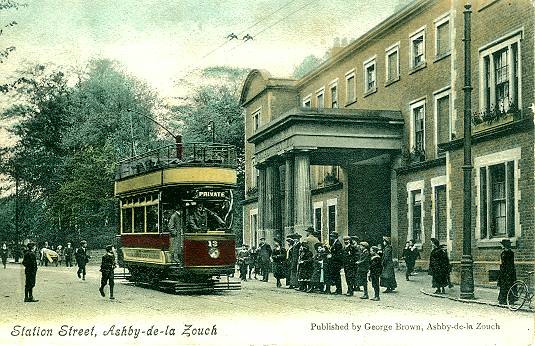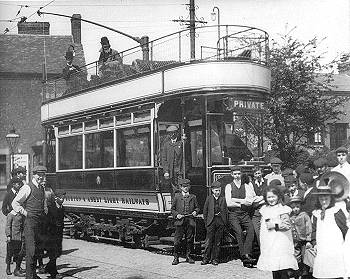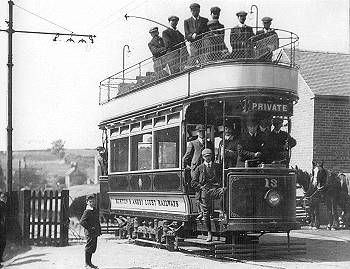

Our postcard shows car 13 of the Burton & Ashby Light Railways standing in Station Road, Ashby in front to the impressive Royal Hotel, close to the terminus at Ashby-de-la-Zouch Midland Railway station. The photograph was probably taken on 8th June 1906 on a testing and inspection run prior to opening the line, judging by the crowd of interested onlookers. A number of contemporary photographs exist of car 13 in various locations on the tramway on this occasion, two of which by Burton photographer J.S.Simnett are shown below, these being at Winshill and Newhall respectively. The postcard was published by George Brown of Ashby-de-la-Zouch, our copy being posted from Ashby on 16th July 1906.
After several failed proposals, Dick, Kerr & Co. constructed this tramway for the Midland Railway Company, work beginning in February 1905. It was just over 10 miles of single 3ft 6in gauge track with passing loops, except for small sections of double track in Swadlincote. Between the towns the tramway was on reserved track. The overhead was double throughout to avoid overhead frogs and improve conductivity.
 The tramway ran in three counties from Burton-upon-Trent in Staffordshire to Swadlincote in the south of Derbyshire and continued to Ashby-de-la-Zouch in Leicestershire. In Burton, the tramway shared about two miles of the tracks of Burton Corporation Tramways from the borough boundary at Winshill to a terminus in Wellington Street, near the Midland Railway station. From Swadlincote a separate line ran south to the railway station at Gresley. Swadlincote and Woodville also had Midland Railway stations, so it can be seen that the tramway, owned by the Midland Railway, was to some extent in competition with its own railways. A final track linked the Ashby and Gresley branches near Swadlincote to form a triangle and a direct route from Woodville to Gresley.
The tramway ran in three counties from Burton-upon-Trent in Staffordshire to Swadlincote in the south of Derbyshire and continued to Ashby-de-la-Zouch in Leicestershire. In Burton, the tramway shared about two miles of the tracks of Burton Corporation Tramways from the borough boundary at Winshill to a terminus in Wellington Street, near the Midland Railway station. From Swadlincote a separate line ran south to the railway station at Gresley. Swadlincote and Woodville also had Midland Railway stations, so it can be seen that the tramway, owned by the Midland Railway, was to some extent in competition with its own railways. A final track linked the Ashby and Gresley branches near Swadlincote to form a triangle and a direct route from Woodville to Gresley.
The public service from Burton to Swadlincote began on 13th June 1906 and Burton to Ashby on 2nd July. Swadlincote to Gresley opened on 24th September and Woodville to Gresley on 15th October. The depot for 24 trams on eight roads was at Swadlincote, next to the railway goods yard. Adjacent to the depot was the power station which, in an area rich in coal, surprisingly utilised two Belgian three cylinder 240 BHP oil engines from the Diesel Engine Co. of Ghent to drive the generators.
Car 13 was the newest of a batch of open-top trams (1-13) built for the system in 1905 by the Brush Electrical Engineering Co. Ltd. of Loughborough. They seated 22 inside and 31 on top. They were on Brush AA 4-wheel trucks, each with two 25hp Westinghouse motors and Westinghouse 210 controllers. A second batch of seven very similar cars (14-20) were supplied in 1906. The livery as built was Midland Railway Crimson Lake and off-white. The Midland Railway crest was carried on the centre of the waist panel and the fleet name on the off-white rocker panel. There were tied-back maroon curtains at the windows. Due to the 1 in 12 gradients, magnetic track brakes and run-back brakes were fitted in addition to the usual hand and rheostatic braking. An unusual feature was an adjustable hand and guard rail across each end. At the driver's end it would be raised up to be level with to the bottom of the destination box, at the rear end it was lowered to give extra protection to passengers on the staircase.
 The history of the tramway was fairly uneventful except for on 8th October 1919 when car 19 lost traction on Bearwood Hill, Burton, ran away backwards and overturned at the bottom, killing two. The driver blamed problems with the sanding gear. After this, larger slipper track breaks were fitted and there was a 4mph speed limit on the hill with a compulsory stop half way down. In 1923 at the "Grouping" the Midland Railway became part of the London, Midland & Scottish Railway (LMS). The trams were repainted into LMS maroon and cream, most noticeably with the previously off-white rocker panels now being in maroon. By 1924 bus competition had cut into the tramway's trade and the pre-war 40 minute service was reduced to hourly and by 1926 had become rush hours only. The tramway closed on 19th February 1927. The service was taken over by Midland Red buses, a company in which the LMS had a large shareholding.
The history of the tramway was fairly uneventful except for on 8th October 1919 when car 19 lost traction on Bearwood Hill, Burton, ran away backwards and overturned at the bottom, killing two. The driver blamed problems with the sanding gear. After this, larger slipper track breaks were fitted and there was a 4mph speed limit on the hill with a compulsory stop half way down. In 1923 at the "Grouping" the Midland Railway became part of the London, Midland & Scottish Railway (LMS). The trams were repainted into LMS maroon and cream, most noticeably with the previously off-white rocker panels now being in maroon. By 1924 bus competition had cut into the tramway's trade and the pre-war 40 minute service was reduced to hourly and by 1926 had become rush hours only. The tramway closed on 19th February 1927. The service was taken over by Midland Red buses, a company in which the LMS had a large shareholding.
Of the trams, ten were sold to the Tynemouth and District Electric Traction Co. although only four entered service there. A number of tram bodies were sold locally. One such tram, car 14, survived and together with parts from 6 and 15 was partly restored, then in 1979 sold to a heritage tramway in Detroit, USA who paid for completion of the restoration and its fitting with an ex Lisbon truck. The tram ran in Detroit from 1980 until 2003. After many years in store, it was sold by Detroit at auction at the end of 2014 for 34,500 dollars and early in 2015 was returned to the UK where it will undergo further restoration and hopefully will one day run again in its home country.
![]() Go to Postcard Of The Month Index
Go to Postcard Of The Month Index